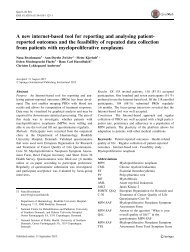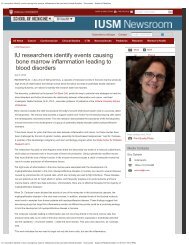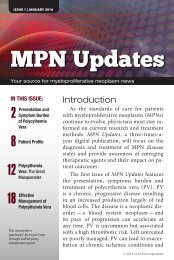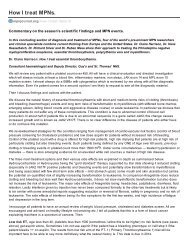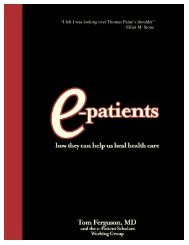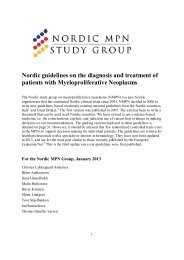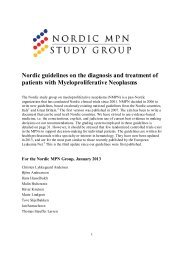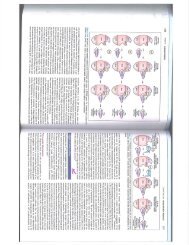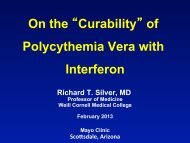Patient information: Treating with IFN-alph2
Patient information from Dr. Hans Carl Hasselbalch On the nature of the disease – MPNs are a hematological cancer with the potential to transform to myelofibrosis and acute leukemia.
Patient information from Dr. Hans Carl Hasselbalch
On the nature of the disease – MPNs are a hematological cancer with the potential to transform to myelofibrosis and acute leukemia.
You also want an ePaper? Increase the reach of your titles
YUMPU automatically turns print PDFs into web optimized ePapers that Google loves.
<strong>Patient</strong> <strong>information</strong>: <strong>Treating</strong> <strong>with</strong> <strong>IFN</strong>-<strong>alph2</strong><br />
mpnjournal.org /patient-inf ormation-treating-<strong>with</strong>-if n-<strong>alph2</strong>/<br />
Commentary on the season's scientif ic f indings and MPN events.<br />
<strong>Patient</strong> <strong>information</strong> from Dr. Hans Carl Hasselbalch<br />
On t he nat ure of t he disease – MPNs are a hematological cancer <strong>with</strong> the potential to transform to myelofibrosis and<br />
acute leukemia – and .<br />
On t he rat ionale and goal f or t reat ment . <strong>IFN</strong>- alpha2 has been known for three decades in the treatment of MPNs<br />
and accordingly it is no longer experimental but routine therapy for patients <strong>with</strong> MPNs at several centres. The<br />
mechanisms of action of the drug are partially unknown but important mechanisms involve enhancement of various<br />
immune cells and accordingly enhancement of “Tumor Immune Surveillance.”<br />
ET and PV pat ient s: These diseases are hematological malignancies which untreated may evolve during years <strong>with</strong> a<br />
steady increase in symptomatic disease burden. There is a risk of thrombosis and bleeding and ultimately a possibility<br />
of transformation into myelofibrosis and/or acute leukemia<br />
The goal of t reat ment wit h <strong>IFN</strong>- alpha2 is t o normalize elevat ed blood count s which likely occurs <strong>with</strong>in the first<br />
6- 12 months in concert <strong>with</strong> a decrease in the need for phlebotomies in the PV- patient . By doing so, significant risk<br />
factors for thrombosis (elevated leukocyte and platelets counts) and bleeding ( highly elevated platelet counts ) will<br />
likely be reduced since it has been shown in several studies that normalization of elevated blood counts during <strong>IFN</strong>alpha2<br />
are associated <strong>with</strong> a decrease in thrombotic and bleeding events .<br />
For t he JAK2V617F- posit ive pat ient : <strong>IFN</strong>- alpha2 likely reduces “the JAK2 –level” <strong>with</strong>in the first year but in many<br />
patients the JAK2- levels significantly decrease in the second ( or third year) of treatment only. After about 5- 7 years of<br />
treatment (in some after 3 years) the JAK2 levels may have reached low levels ( below 1 %) in those patients starting<br />
<strong>with</strong> “high JAK2 level disease” ( > 50 %) At this point I may discontinue treatment and observe <strong>with</strong> regular monitoring (<br />
thrice yearly) of blood counts , including the JAK2V617- allele burden. Several patients today are followed off therapy<br />
<strong>with</strong> normal peripheral blood counts , “low- burden JAK2 “ ( < 1- 5 % mutated alleles) and are feeling very well <strong>with</strong>out<br />
any complaints from their MPN- disease.<br />
The significance of achieving normal blood counts and “low- burden JAK” in terms of survival and later development of<br />
myelofibrosis and acute leukemia is unknown ( no randomized studies due to the rarity of the diseases ). However,<br />
considering the biology of all other cancers and in the context that we have reduced the “tumor burden” to a minimum –<br />
only detectable by very sensitive methodology ( qPCR JAK2V617F ), The risk of transformation to myelofibrosis and<br />
acute leukemia is far less <strong>with</strong> minimal tumor burden remaining to elicit such transformations.<br />
Inf ormat ion t o t he pat ient on t oxicit ies relat ing t o <strong>IFN</strong>- alpha2 t reat ment , how t o manage t hem and how t o<br />
administ er <strong>IFN</strong>- alpha , dosage and schedule f or monit oring of t reat ment<br />
Treatment <strong>with</strong> <strong>IFN</strong>- alpha2 may be associated <strong>with</strong> side effects, which – on low- dose <strong>IFN</strong>- alpha2- are but modest and<br />
transient in the large majority of patientsm including flu- like symptoms after the first 3- 5 injections. Many patients have<br />
read about <strong>IFN</strong>- alpha2, some being reluctant to start treatment referring to data on drop- out rates of 30- 50 % . Many of<br />
these figures are based upon previous studies using <strong>IFN</strong>- alpha2 thrice weekly and in much larger doses accounting for<br />
the high rates of side effect and reported toxicity in several previous studies . I treat <strong>with</strong> pegylated <strong>IFN</strong>- alpha2 ,<br />
requiring administration once weekly and probably after 1- 2 years every 10 day or every second week .<br />
I use either inj. Pegasys ( pegylated <strong>IFN</strong>- alpha2a , Roche), given in a dosage of 45- 90 ug subcutaneously (sc.) per<br />
week or inj. PegIntron ( pegylated <strong>IFN</strong>- alpha2b, Merck) in a dosage of 30- 50 ug sc. About half an hour before the first<br />
injection- administered in the evening before bed- time, your advised to take 1 Tbl. Paracetamol 1 g. During the first 3- 5<br />
injections the patient is advised to take 1 Tbl. Paracetamol 1 g x 3 (4) daily on days 1 - 5 in order to dampen flu- like<br />
symptoms which usually vanish thereafter.<br />
Other side effects include fatigue ( which may persist in a subset of patients for several months ) , depression ( a history
of depression is a relative contraindication) , thyroid dysfunction abnormal liver function tests (most often transient not<br />
a contraindication for continuing <strong>IFN</strong>- alpha2 and usually normalize after dose reduction or short discontinuation of <strong>IFN</strong>alpha2<br />
) , and very rarely hair thinning, pulmonary or renal impairment. Sexual dysfunction may be seen . Contact me<br />
immediately if you experience any discomfort <strong>with</strong> the treatment other than transient flu- like symptoms .<br />
Although the goal of treatment is normalization of elevated blood counts in some cases the leukocyte or platelet counts<br />
will transiently turn subnormal but this does not usually matter . Blood counts will be monitored on a regular basis <strong>with</strong><br />
blood samples ( Hb- concentration, white blood cell count count , platelet count, liver and renal function tests ) every<br />
second week the first 2 months and thereafter every month or every second or third month when blood cell counts have<br />
normalized (“complete hematological remission”) .<br />
Before and about half yearly after starting treatment I will also monitor thyroid function (plasma TSH). In the JAK2V617Fpositive<br />
patients I will assess the “JAK2- level” every 3 or 4 months . I will tell my patients that achieving normal<br />
peripheral blood counts do not necessarily imply a concomitant decline in the JAK2V617F- allele burden, which may<br />
show a definite decline later in the second or third year of treatment. After 3 and 5 years I will perform a bone marrow<br />
biopsy to assess the impact of <strong>IFN</strong>- alpha2 upon the bone marrow, including potential regression of fibrosis.<br />
Inf ormat ion t o t he pat ient on PegInt ron and Pegasys in low- dose in regard t o t oxicit ies , and combinat ion<br />
t herapy wit h hydroxyurea<br />
We have the option to shift from PegIntron to Pegasys and vice versa depending upon the individual tolerance to the<br />
drug given. In addition, the dosage will be tapered to the lowest dose – possible administered every second week –<br />
which secures normal blood counts . Accordingly, if side effects are experienced, we have the possibility to lower the<br />
dose more rapidly – and, in addition, to combine <strong>IFN</strong>- alpha2 <strong>with</strong> hydroxyurea (HU) or anagrelide ( the latter agent<br />
being used in those patients having elevated platelets only ) .<br />
Inf ormat ion on hydroxyurea , efficacy and safety, toxicities <strong>with</strong> particular focus on skin toxicity, skin cancer and the<br />
concern on leukemogenicity after long- term exposure<br />
HU administered orally has been used during the last 30 years in patients <strong>with</strong> MPNs. It effectively normalizes elevated<br />
blood cell counts in the large majority of patients and it is the single agent which in larger randomized studies has<br />
shown to reduce the increased risk of thrombosis and bleeding in MPNs. However, despite normalizing elevated<br />
leukocyte and platelet counts HU does not fundamentally influence disease progression at the molecular level.<br />
Treatment <strong>with</strong> HU has not proven to induce sustained normalization of blood cell counts or sustained lowering of the<br />
JAK2V617F allele burden which is being recorded in a substantial and increasing number of patients <strong>with</strong> ET and PV<br />
during long- term treatment <strong>with</strong> <strong>IFN</strong>- alpha2. Furthermore, there is concern that long- term exposure to HU ( > 10 years)<br />
may elicit a pre- stage ( myelodysplastic syndrome) to acute myelogenous leukemia (AML) or overt AML. Therefore,<br />
HU is not used in younger patients in several centers , eg. in UK . In other countries – eg. Denmark – <strong>IFN</strong>- alpha2 is also<br />
offered to elderly patients ( also those above 60 years ), since the elderly in general tolerate <strong>IFN</strong>- alpha2 very well when<br />
used in the dosages mentioned above.<br />
In determining the choice between <strong>IFN</strong>- alpha2, hydroxyurea and anagrelide ( the latter agent for patients <strong>with</strong> elevated<br />
platelet counts only) significant side effects and toxicities of hydroxyurea , including the risk of significant skin toxicity (eg<br />
eczema, leg ulcers and skin cancer ) , stomatitis, diarrhea, fatigue, and rarely monosymptomatic fever or pulmonary<br />
dysfunction need to considered.<br />
Inf ormat ion t o t he myelof ibrosis pat ient in regard t o <strong>IFN</strong>- t reat ment<br />
For patients <strong>with</strong> hypercellular myelofibrosis , here’s why I recommend <strong>IFN</strong>- alpha2 . You are in an early stage of<br />
myelofibrosis and <strong>IFN</strong> has been shown to resolve bone marrow fibrosis and normalize the blood cell count while<br />
reducing spleen size and alleviating hypermetabolic and pressure symptoms from the enlarged spleen. The treatment<br />
has to be given for several months ((6- 12 months) before substantial improvement is recorded . For the patient <strong>with</strong> huge<br />
splenomegaly (below umbilical level) and/or pronounced hypermetabolic symptoms (weight loss, night sweats, fatigue,<br />
low- grade fever) I do not recommend <strong>IFN</strong> but instead a JAK2- inhibitor.<br />
- H.C.Hasselbalch<br />
© MPN Quarterly Journal, 2013. This work is licensed under a Creative Commons Attribution- NonCommercial No- Derivs
3.0 Unported License. MPNquarterly@gmail.com



